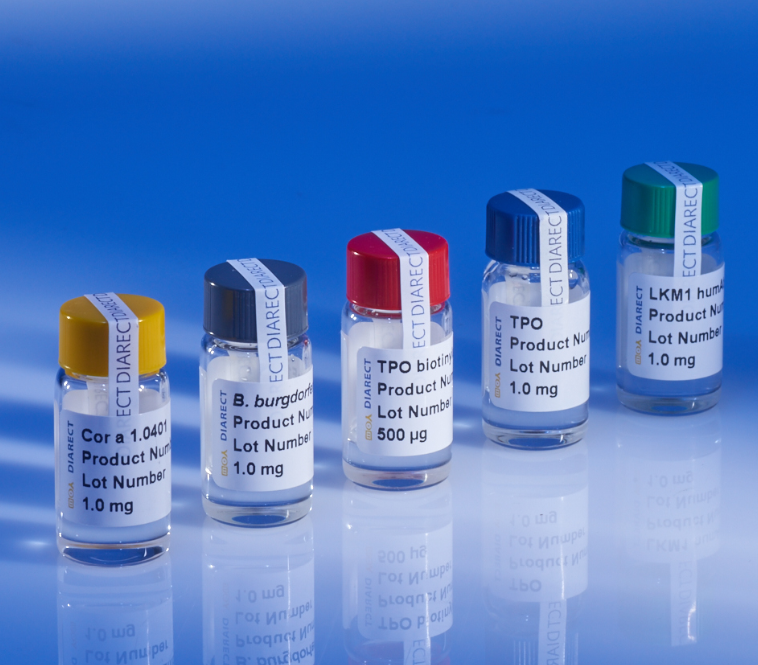U1-snRNP 68 Protein (68 kDa)/U1小核糖核蛋白(68 kDa)
U1-snRNP 68 Protein (68 kDa)
Diseases:
Systemic Lupus Erythematosus (SLE)
Mixed Connective Tissue Disease
Small nuclear ribonucleoprotein complexes (abbreviated as U-snRNP) are essential for splicing of precursor mRNA molecules. U1-snRNP is the most abundant RNP particle in the nucleus and consists of one small uridylate-rich RNA (U1 RNA) complexed with several proteins: the three 68/70 kDa, A, C polypeptides are unique to the U1-snRNP particle, whereas 7 so-called Sm proteins (B/B, D1, D2, D3, E, F, G) form a core subparticle that is common to all U-snRNP complexes.
Both the U1-specific proteins and the Sm core particle are targets of autoantibodies which classically have been called the RNP and RNP-Sm specificities, respectively. A clean diagnostic distinction of these specificities has been complicated by the biochemical difficulties of producing clean subparticle fractions from native sources. The use of single recombinant proteins as antigenic targets guarantees a much higher sensitivity and specificity and is the only way to determine RNP antibodies sensu stricto without the disturbing influence of Sm antigens; also with single U1 proteins antibodies will be detected which can be missed because of steric hindrance when using the RNP-Sm complex in an assay.
Autoantibodies to U1-snRNP are present in 95% of patients with mixed connective tissue disease (MCTD) and 30% of patients with SLE. Antibodies against the 68/70-kDa protein are known to have a high clinical significance in MCTD patients. The "68/70-kDa" nomenclature of this protein refers to the fact that different splice variants of the protein are found in human cells.
U1-snRNP 68 (68 kDa) protein from DIARECT is expressed in E.coli.
相关疾病: 系统性红斑狼疮(SLE),混合性结缔组织病混合性结缔组织病
(MCTD)是一种以系统性红斑狼疮(SLE),系统性硬化症(SSc),多发性肌炎/皮肌炎(PM/DM)及类风湿性关节炎为特征的综合病症。特征性的血清学表明混合性结缔组织病(MCTD)不同于其他的结缔组织病(CTDs)在于有高滴度的荧光抗核抗体,呈斑点型以及U1小核糖核蛋白(U1-snRNP)特异性自身抗体的存在,MCTD血清的U1-snRNP特异性抗原(68/70 kDa 抗原,蛋白A抗原,蛋白C抗原)的抗体的滴度比SLE血清中的高。MCTD的典型临床综合征的特征为:高频率的雷诺现象和抗U1-snRNP,低频率的肾炎和抗Sm(SLE相反)小核核糖核蛋白复合物(U-snRNP)在前体信使RNA剪接中起到极为重要的作用。细胞核中大多数RNP颗粒是U1-snRNP,它是由一个富含尿苷酸的小片段RNA(U1-RNA)和几种蛋白质组成的复合物。U1-68/70kDa,U1-A和U1-C这三个多肽仅出现在U1-snRNP颗粒中,然而,另外7个Sm蛋白(B/B, D1, D2, D3, E, F, G)形成的亚颗粒通常存在于所有的U-snRNP复合物中。U1特异性蛋白(U1-68/70kDa,U1-A和U1-C蛋白统称为RNP抗原)和Sm核心颗粒(RNP-Sm抗原)都是自身抗体的靶抗原。由于很难从自然界纯化出这些小核核糖核蛋白复合物的亚颗粒蛋白,这就给临床诊断结果的特异性和准确性带来影响。U1-snRNP独有的蛋白和Sm核心颗粒是自身免疫抗体蛋白分别对各自的抗体有特异性。若用RNP-Sm 复合物做检测会出现位阻现象而不能显示特异性。使用单一的重组蛋白作为抗原标靶保证了非常高的灵敏性和特异性, 这是一种不受Sm抗原影响的RNP自身抗体的检测方法。并且与应用RNP-Sm复合物做抗原相比,在检验中使用单一的U1蛋白能够检测出更多的自身抗体,因为RNP-Sm复合物的形成掩盖了很多自身抗体的识别位点。在95%混合性结缔组织疾病(MCTD)和30%的SLE的患者中存在U1-snRNP自身抗体。抗68/70-kDa蛋白抗体在MCTD患者中临床重要性较高。68/70-kDa蛋白的命名是依据人细胞中所找到的这个蛋白的不同剪切体。
DIARECT生产的U1-snRNP 68(68kDa)是在E.coli中表达的。




